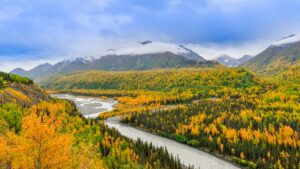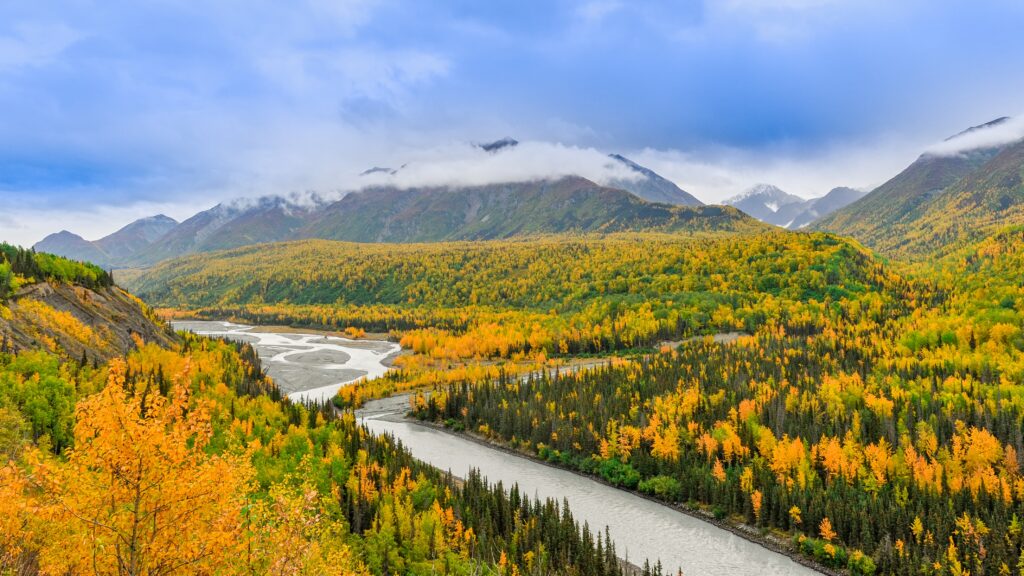By Carli Berasi
Of the 2,428,213,158 acres that make up the land area of the United States,[1] a mere twelve percent is protected land that “has been conserved as national parks, wilderness areas, permanent conservation easements, state parks, national wildlife refuges, national monuments, or other protected areas.”[2] Protected lands, which comprise twenty-four percent of the United States’ land mass, benefit from safeguards by the United States for such purposes as nature conservation, recreation, grazing, and wildlife defense.[3] As such, the government (both at the federal and state level) can protect and regulate activities that occur in these areas, including conservation, recreation, and measured commercial activity.[4]
Alaska only encompasses 365 million acres of the United States’ total land area, yet singularly contributes to over half of the United States’ “federally-designated wilderness.”[5] Eighty-eight percent of Alaska is owned by the public, and it possesses “[thirty-two] state game refuges, critical habitat areas, and wildlife sanctuaries across the state, totaling over 3.2 million acres.”[6] Following the passage of the Alaska National Interest Lands Conservation Act (“ANILCA”) in 1980, 148 million acres in Alaska were “dedicated to conservation purposes . . . constituting 70 percent of all national park lands in America, 80 percent of wildlife refuge acreage, and 53 percent of designated Wilderness in the National Wilderness Preservation System.”[7] As a result, Alaska possesses the coveted status of being one of the most environmentally protected states[8] and functions as a haven for the ecological diversity it possesses.[9]
Many of the protected land areas, as well as residential and commercial areas, in Alaska are inaccessible by visitors through roadways.[10] For example, only three of the eight national parks in Alaska are “accessible by road.”[11] Further, “[a]s many as 8 out of 10 of Alaska’s communities are not connected to the road system” established in Alaska.[12] This means that Alaska’s visitors and residents (of which there are 724,357—firmly securing its spot on the list of least populated states[13]) can be faced with significant accessibility concerns associated with living in and traveling within the state.[14] As one article noted, “Alaska is roughly twice the size of Texas, with a road system about the size of Hawaii’s. This means that the vast majority of Alaska cannot be accessed by highway vehicle.”[15] Startlingly, this amounts to a mere twenty percent of Alaska being “accessible by roads.”[16]
While some might view Alaska’s lack of accessibility as a small price to pay for the adventurous charm of the “Last Frontier’s” remote, rugged, and awe-inspiring landscape, as well as flourishing wildlife,[17] others focus on the pitfalls associated with a more “remote” way of life.[18] While it is acknowledged that tourism activities resulting from the allure of Alaska’s protected landscape has substantially bolstered the state’s economy, “many Alaskans still believe federal management is too restrictive and has held back potential growth in tourism and other industries.”[19] Further, the inaccessibility of some remote towns in Alaska creates obstacles for residents to obtain basic provisions.[20]
In 2018, these two perspectives collided when the United States government and King Cove Corporation structured a land-exchange agreement.[21] The land exchange would give King Cove Corporation a plot of land within Izembek National Wildlife Refuge (“the Refuge”) for the purpose of building a twelve-mile road to connect King Cove with Cold Bay.[22] In response to the agreement, the Friends of Alaska National Wildlife Refuges, among other conservation groups, filed a lawsuit against the Trump Administration to prevent the swap and construction, asserting that the agreement “will result in the removal of designated Wilderness from the Refuge for the purpose of constructing a road through the heart of Izembek.”[23]
Izembek National Wildlife Refuge is not only a wildlife haven but also has been a protected area since 1960 due to “its ecologically unique habitat and wilderness characteristics.”[24] The Refuge is 315,000 acres,[25] and it is also home to many “federally-protected species,” including the northern sea otter and the Stellar sea lion, as well as migratory fowl, brown bears, and caribou.[26] Opponents of the land-swap and road assert both legal arguments and environmental concerns against the land exchange, such as that sanctioning the land exchange violated ANILCA, since “the exchange does not meet ANILCA’s conservation purposes or the specific purposes of Izembek Refuge to protect wilderness and wildlife values.”[27] Additionally, opponents of the road “have long-standing interests in protect[ing] Izembek from a land exchange and road construction . . . includ[ing] preserving and enjoying the wildlife, habitat, and wilderness values of Izembek . . . .”[28] Notably, prior to the Trump Administration’s agreement, the Obama Administration had years earlier rejected such an arrangement due to similar concerns, as the Interior Secretary stated that “the road ‘would lead to significant degradation of irreplaceable ecological resources that would not be offset by the protection of other lands to be received under an exchange,’” and “there were other ways to get from one town to the other.”[29]
King Cove and Cold Bay, which are “two remote towns on the Aleutian Islands archipelago,” can currently only reach each other via air or sea travel, and this new road through the Refuge would be the first road connecting the two areas.[30] Significantly, the road would enable King Cove residents to reach Cold Bay’s “larger, all-weather airport to ‘facilitate medical evacuations.’”[31] King Cove residents believe this is necessary, as its local airport “is small and often closed by bad weather conditions . . . .”[32]
Initially, the federal district court ruled in favor of the plaintiffs, “void[ing] [the] land exchange deal,” as the government did not provide adequate justification for now engaging in the agreement, since the government had entered a “previous decision that alternatives to a road exist and that road would cause significant environmental harm.”[33] Following this ruling, the U.S. Interior Department entered into a new agreement with King Cove Corporation, similar to the original land-swap arrangement, differing in that “the swap is not limited to 500 acres, and the agreement does not say the road is limited to noncommercial use—though it does specify it would be unpaved.”[34] Again, a lawsuit was filed to prevent the land-swap agreement and thus the road from being built, alleging that “the justification [for the new swap agreement] is still inadequate.”[35] The plaintiffs emphasized not only the ecological significance of the land, but also that King Cove is so remote that a road would not eliminate their safety concerns.[36] Proponents countered that “the road would be passable nearly all the time and is the only practical option.”[37] Once again, the district court found in favor of the plaintiffs, as “the administration’s new justification for the swap ‘offers no new information or data to justify his contrary finding that the value of the added acreage to the refuge system counters the negative effects of a road through Izembek . . . .’”[38]
However, in March 2022, the Ninth Circuit Court of Appeals reversed course from the previous district court decisions. The court stated that “the value of a road to the King Cove community outweighed the harm that it would cause to environmental interests . . . ”[39] and held that the government “did not violate ANILCA because ANILCA’s protections would no longer apply with the completion of the exchange and the lands are then private . . . [and the district court] erred in finding that ANILCA’s purposes exclude social and economic concerns and that the Secretary has broad discretion to reverse course on policy decisions.”[40] In response to the decision, the plaintiffs have committed to “continue the fight to save the Izembek Refuge.”[41]
This case demonstrates the tension between infrastructure and progress and preserving our nation’s protected lands. While the proposed road through Izembek may seem inconsequential at only twelve miles, it presents significant concerns that such development might result in a slippery slope towards a pattern of building infrastructure in environmentally protected areas. As noted by the Trustees for Alaska, “[a]llowing a road through Izembek would set a precedent that would imperil the entire Refuge System.” When alternatives exist, therefore, we must safeguard, respect, and protect our designated public lands.
[1] State Area Measurements and Internal Point Coordinates, United States Census Bureau, https://www.census.gov/geographies/reference-files/2010/geo/state-area.html (Dec. 16, 2021).
[2] Matt Lee-Ashley et al., How Much Nature Should America Keep? cap (Aug. 6, 2019) https://www.americanprogress.org/article/much-nature-america-keep/.
[3] America’s Protected Areas, ESRI, https://storymaps.esri.com/stories/2017/protected-areas/ (last visited Mar. 30, 2022).
[4] Id.
[5] Who Owns Alaska?, Resource Review 1, 3 (n.d.), https://rdc.memberclicks.net/assets/Resource-Reviews/rr.se.whoownsalaska.2009.pdf (Specifically, fifty-eight million acres of the 109.5 million total acres of “federally-designated wilderness” exist in Alaska.).
[6] Conservation Areas, Alaska Department of Fish and Game, https://www.adfg.alaska.gov/index.cfm?adfg=conservationareas.main#:~:text=Alaska%20contains%20365.5%20million%20acres,of%20fish%20and%20wildlife%20habitats (last visited Mar. 30, 2022).
[7] Who Owns Alaska?, supra note 5, at 2.
[8] Annalise Mantz, States that Are Conserving the Most Land, Stacker (Sept. 10, 2018), https://stacker.com/stories/1614/states-are-conserving-most-land.
[9] About the Region, National Park Service, https://www.nps.gov/locations/alaska/about-the-region.htm (last visited Mar. 30, 2022).
[10]Alaska’s National Parks & Public Lands, Alaska.Org, https://www.alaska.org/destinations/parks-and-public-lands#:~:text=3%20National%20Parks%20are%20accessible,a%20boat%20or%20air%20taxi (last visited Mar. 30, 2022).
[11] Id.
[12] Infrastructure for All Alaskans, InfrastructureReportcard.org, https://www.infrastructurereportcard.org/wp-content/uploads/2017/02/Alaska-RC.pdf (last visited Mar. 30, 2022).
[13] US States – Ranked by Population 2022, World Population Review, https://worldpopulationreview.com/states (last visited Mar. 30, 2022).
[14] Infrastructure, supra note 12 (stating that “Large portions of Alaska are only accessible by air or water”).
[15] Accessing Alaska: What’s the Best Way to Get Around, Alaska Outdoors Supersite, https://alaskaoutdoorssupersite.com/accessing-alaska (last visited Mar. 30, 2022).
[16] Liz, Transportation in Alaska, Golden North Van Lines (July 11, 2019), https://www.goldennorthvanlines.com/transportation-in-alaska/.
[17] Kraig Becker, 7 Reasons Why Alaska is Still ‘The Last Frontier’, Men’s Journal, https://www.mensjournal.com/travel/7-reasons-alaska-still-last-frontier/#:~:text=But%20perhaps%20the%20most%20well,close%20of%20the%2019th%20century (last visited Mar. 30, 2022).
[18] Alex DeMarban, Federal Appeals Court Rules in Favor of Village’s Efforts to Extend a Road Through Alaska’s Izembek National Wildlife Refuge, Anchorage Daily News (Mar. 16, 2022), https://www.adn.com/alaska-news/2022/03/16/court-rules-in-favor-of-villages-efforts-to-extend-a-road-through-alaskas-izembek-national-wildlife-refuge/.
[19] Who Owns Alaska?, supra note 5.
[20] Zachary Crockett, How a Remote Alaska Town Gets Its Groceries, Hustle (May 3, 2020), https://thehustle.co/how-a-remote-alaska-town-gets-its-groceries/.
[21]Dan Joling, Deal Reached on Land Swap for Road Through Izembek Wildlife Refuge, Anchorage Daily News (July 24, 2019), https://www.adn.com/alaska-news/rural-alaska/2019/07/24/deal-reached-for-land-swap-for-road-through-izembek-wildlife-refuge/.
[22] Id.
[23] Complaint at 6, Friends of Alaska National Wildlife Refuges v. Zink (D. Alaska 2018) (No. 3:18-cv-00029-TMB), https://www.biologicaldiversity.org/programs/public_lands/pdfs/Izembek-2018-01-30-Complaint.pdf.
[24] Complaint, Friends of Alaska National Wildlife Refuge, 3:18-cv-00029-TMB at 6.
[25] Hillel Aron, Controversial Road on Alaska Peninsula Gets Another Chance After Ninth Circuit Steps In, Courthouse News Service (Mar. 16, 2022) https://www.courthousenews.com/controversial-road-on-alaska-peninsula-gets-another-chance-after-ninth-circuit-steps-in/.
[26] Complaint at 10–11, Friends of Alaska National Wildlife Refuges v. Zink (D. Alaska 2018) (No. 3:18-cv-00029-TMB.
[27] Press Release, Chessie Sharp, Friends of Alaska National Wildlife Refuges, Izembek (June 7, 2020), https://alaskarefugefriends.org/izembek-press-release/.
[28] Complaint at 6, Friends of Alaska National Wildlife Refuges v. Zink (D. Alaska 2018) (No. 3:18-cv-00029-TMB).
[29] Aron, supra note 25.
[30] Id.
[31] Id.
[32] Id.
[33] Court Win Protects Izembek!, Trustees for Alaska (Mar. 29, 2019), https://trustees.org/court-win-protects-izembek/.
[34] Liz Ruskin, It’s Back: U.S. Interior Dept. Signs New Land Deal for King Cove Road, KTOO (July 23, 2019), https://www.ktoo.org/2019/07/23/its-back-u-s-interior-dept-signs-new-land-swap-deal-for-king-cove-road/.
[35] Liz Ruskin, Environmental Groups File New Lawsuit to Block New Izembek Land Swap Deal, KTOO (Aug. 7, 2019), https://www.ktoo.org/2019/08/07/environmental-groups-file-new-lawsuit-to-block-new-izembek-land-swap-deal/.
[36] Id.
[37] Id.
[38] Laura Bies, Court Halts Road Through Izembek National Wildlife Refuge, The Wildlife Society (June 10, 2020), https://wildlife.org/court-halts-road-through-izembek-national-wildlife-refuge/.
[39] Aron, supra note 25.
[40] Jamie Rappaport Clark, Ninth Circuit Ruling Threatens Land, Water, Wildlife in Izembek Refuge, Defenders of Wildlife (Mar. 16, 2022) https://defenders.org/newsroom/ninth-circuit-court-ruling-threatens-land-water-wildlife-izembek-refuge.
[41] Id.



